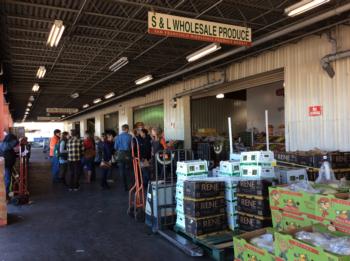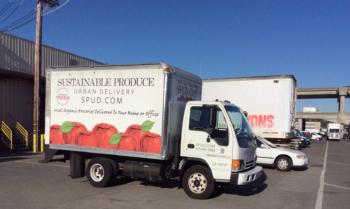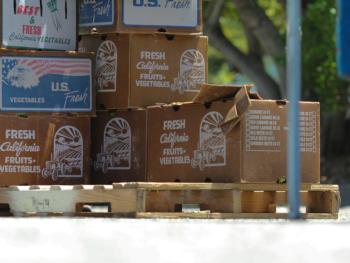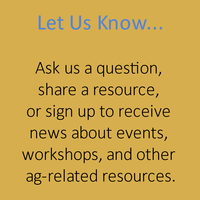Wholesale ahead
by Julia Van Soelen Kim, UCCE Food Systems Advisor
It’s early morning at the San Francisco Wholesale Produce Market—the closest terminal produce market to Marin County—and the steady pace and constant flow of people and produce is dizzying. Farmers pull up in pickup trucks to deliver their freshly harvested produce in boxes, refrigerated distribution trucks beep as they back up to loading docks, and there is a bright orange blur from forklifts moving pallets.

From talking with farmers in Marin County and the North Bay, I’ve found that wholesale is a confusing term for many. Wholesale means to sell goods in large quantities which will then be re-sold to others. It sounds simple enough, but what one farmer considers wholesale, another farmer doesn’t. And for many farmers, their gut reaction is to say that they simply aren’t interested in selling their products wholesale. They prefer to direct market, or sell their products directly to their end customers through local farmers markets, farm stands, and Community Supported Agriculture (CSAs). That’s because they want to be able to make a connection with the people who are going to eat what they’ve produced and let them know how the food was grown or raised. They also want to be price setters, not price takers, and they want to know that by cutting out the “middle men,” they’re getting top dollar for their high quality products. In fact, many say, they can’t afford to sell wholesale.
In contrast, for most buyers, including grocery stores, restaurants, schools, and institutions, being able to purchase wholesale is a necessity. It’s how they run their businesses efficiently. It’s how they ensure that they have enough food on hand to stock their shelves and put on their plates, and it’s how they are able to purchase what they need to at the time, frequency, volume, price point, and ease that they expect.
While wholesale is not for every farmer because of its most obvious disadvantage—the prices they receive are almost always lower than through direct marketing—there are important advantages. Farmers can create economies of scale by specializing in fewer items that they are more skilled at growing or that are more suited for their climate, they can gain new production efficiencies, and they can significantly reduce the time and resources they spend transporting their products to and staffing farmers markets. Through wholesale, both farmers and buyers can reduce the number and complexity of contacts needed to make sales, making the transaction cost per unit of produce sold far lower than through direct sales. Additionally, wholesale can be a great option for any farmer who is not a “people person” because it requires making fewer connections with buyers than direct marketing.
This is why, standing amongst the hustle and bustle of the San Francisco Produce Market, I’m convinced that if we want to grow our local food economy, wholesale has to be part of the equation. And so I wonder, how do we bring these two contrasting views of wholesale closer together in order to foster a more local, resilient, and economically viable food system?

From what I’ve seen, the best kinds of wholesale transactions are a negotiation between farmers and buyers, in which both parties understand the needs and constraints of the other party and honestly assess if they are the right ones to meet those needs. In essence, just like with our local farmers markets, farm stands, and CSAs, it all comes down to the relationships between local farmers and local buyers, and increasingly, the stories that add value to their products. In fact, there is a term for this trend: values-based supply chains. According to Gail Feenstra, with the UC Sustainable Agriculture Research and Education Program, values-based supply chains are wholesale channels that provide additional marketing options for small- to mid-sized, values-based producers, increasing consumers’ access to their products, and allowing them to participate in "farm to fork" efforts. She explained that values-based supply chains are created “when middlemen are good at telling the stories of the family farmers they buy from to the people who they sell to.” Colleague David Visher agreed, explaining that it is important for farmers to “make sure that your delivery person, you, your label, your prices, your produce pack, and your attitude all tell the same story.”

I think part of what makes wholesale confusing is that it encompasses a wide range of scales, needs, services, and price points—only some of which are based on keeping intact and communicating messages about farmers’ values. According to Thomas Nelson, a supply chain analyst for the UC Sustainable Agriculture Research and Education Program, “businesses that are located at wholesale markets, purchasing and selling at wholesale prices, and distributing products with fleets of trucks can be called very different things.” Below are just a few of the terms that get tossed around along with the produce.
Brokers negotiate contracts for the purchase and sale of the product but do not take title of the product.
Food hubs offer a combination of aggregation, distribution, or marketing services of source-identified locally and regionally produced foods, providing small and mid-sized producers with entry into new markets that would be difficult or impossible to access on their own.
Grower-Packer-Shippers not only grow and harvest produce, they also pack their produce and other farmers’ produce and transport it to buyers.
Jobbers purchase products from growers, packers, wholesalers, or distributors and resell products to retailers such as restaurants, or to other wholesalers.
Produce distributors source products from other wholesalers or directly from farmers and transport product from their centralized locations (such as the San Francisco Produce Market) to their retail customers, including supermarkets, grocery stores, restaurants, and institutions.
Wholesalers work directly with farmers, food hubs, distributors, and others to aggregate produce and sell to others.
Wholesale markets, also called “Terminal Markets,” located in or near urban centers and serve as the final or “terminal” point for the wholesale produce marketing channel. Terminal market sales activity is based on the USDA AMS Market News Reports which are issued daily based on information provided from the 15 major U.S. terminal markets, including price data on the commodities traded at the markets.
It is no wonder that the world of wholesale can be confusing to a new farmer, or even a veteran farmer venturing into a new market channel. But as David advises farmers visiting the San Francisco Wholesale Produce Market for the first time, “don’t be intimidated by the direct language and curt manner that you might hear and see. Buyers want you to say up front and quickly what you have, when you will have it, how much it will cost, and why it is better.”



